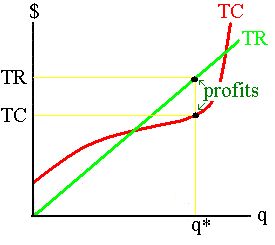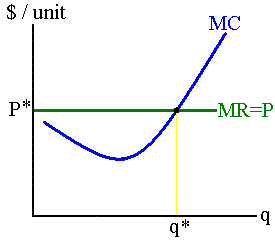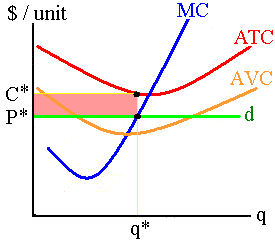|
Competitive Markets
|
- Purely Competitive Firms - accepts
the market price in order to sell their products. They are also
called price takers.
- Characteristics:
- All firms produce an identical product
- Consumers do not care where they buy the product
- A large number of firms are in the market
- Each firm supplies only a small portion of the total supplied to
the market
- One firm cannot influence the price of the market
- No barriers to entry or exit exist
- Example: If one firm earns economic profit, then rival firms can easily enter the market and try to earn profits
- The firms maximize profit by adjusting production level, but cannot influence market price.
- All firms produce an identical product
- Characteristics:
- Why study price takers?
- Understand why competition is important
- Clarifies differences between price-takers and other firm types
- Agricultural markets tend to be price takers
1. Marginal Revenue (MR) - is the change in total revenue when output increases by one unit.
- Refer to graph.
- The farmer only sees the market price.
- If the farmer sells 1 bushel, he receives $2 (MR). The farmer sells another bushel, he receives another $2 (MR).
- If the farmer raises his price of corn above the market price,
then nobody buys it.
- Consumers buy the bushel from competitors for $2
- If the farmer sells his corn below the market price, then he lowers his revenue (loses money)
- Thus, he can sell all his corn at the market price, so MR = P* = $2.
| Price Taker's Demand Curve | |
|---|---|
| A Farmer | The Market |
| Price | Price |
 |
 |
| Quantity | Quantity |
2. Profit maximization - the price taker will expand output in the short run until:
P* = MR = MC
Note: The market price is P* and marginal cost is MC.
Further, the MR = MC maximizes profits for monopolies, oligopolies, and
monopolistically competitive firms, while MR = P* is only valid for price
takers.
| This rule maximize the firm's profits (or minimize its losses) | |
| Example: If MR = $3 and MC = $2. MR > MC, the firm will
collect $3 for selling that last "additional" unit that only costs
$2 to produce. Profit increases by $1.
If MR = $3 and MC = $5. MR < MC, the firm will collect $3 for selling that last unit that costs $5 to produce. The firm should reduce production by 1 unit to increase profits. |
- Price takers earn profits by maximizing total revenue (TR) and
minimizing total costs(TC)
- Total Revenue (TR) = P * q
- Profits = TR - TC
- Taking vertical slices (adjusting output q) until TR -TC is maximized, which is shown below:
| Firm |
|---|
| Price / Per-unit costs |
 |
| The point where profit is maximized is at the production level q when MC = MR = P* |
 |
| Quantity |
- Using the marginal cost, market price, and average total cost, we
can show a competitive firm earning a profit.
- Firm earns a profit when Market Price > ATC
- The "green" rectangle is firm's profit
- The derivation is:
Profit = Total Revenue - Total Cost
Profit = P q - ATC q = (P - ATC) q
| Firm |
|---|
| Price / Per-unit costs |
 |
| Quantity |
3. Losses and going out of business.
- Short-run.
- A firm experiencing losses, but covering its average variable costs, will operate in the short run.
- Example: AVC = $10 per product, AFC = $10, and the firm produces
where MR = MC.
- Competitive market: P* = MR
- If P* = $5; firm cannot cover its variable costs, so it shuts down; it still pays its fixed costs
- If P* = $10; firm covers its variable costs, but earns a loss
- If P* = $15; firm still earns a loss, but also covers some of its fixed costs
- If P* = $20; firm breaks even
- If P* > $20; firm earns an economic profit
- Competitive market: P* = MR
- Shutdown - temporary halt in the
production or operation of a business.
- A firm shuts down when P* < AVC
- The firm still pays fixed costs during the shutdown.
- Motels, restaurants, and theme parks shutdown during off seasons
- Long-run.
- A firm will "go out of business" in the long run whenever P < ATC.
- Going out of business - firm
permanently exits the market and avoids paying fixed costs.
- If P = $0.25 for a generic soda and the ATC = $0.50.
- This firm cannot continue to operate for a long time with losses.
| A Firm | |
|---|---|
| Price / Per-unit costs | |
| Firm produces quantity q where MC = MR = P ATC > Market Price, the firm is earning a loss or profit is negative. Profit = Total Revenue - Total Cost Profit = P q - ATC q The loss = "The red area" |
 |
| Quantity |
4. A firm maximizes profits when it produces at P* = MC. A firm's short-run supply curve is its marginal cost curve above average variable cost. Firm produces if the market price exceeds its average variable costs.
Law of Supply - as the price of a
product increases, firms will increase quantity supplied.
| A Firm's Cost Curves | A Firm's Supply Curves |
|---|---|
| Price / Per-unit costs | Price / Per-unit costs |
 |
 |
| Quantity | Quantity |
- In the long-run, firms earn zero economic profit
- A normal rate of return, i.e. accounting profit
- If P* > ATC, firms earn an economic profit
- New firms enter the market
- SR Supply increases while the price decreases until it equals P = ATC
- Economic profit = 0
- If P* < ATC, firms earn a loss
- Some firms leave the market
- SR supply decreases, while the price increases until it equals P = ATC
- Economic profit = 0
- Long-run equilibrium
- The market determines the price and quantity of milk
- P* = $2 and market quantity = 10 (thousand)
- Each firm supplies q quantity of milk
- Earn zero economic profit
- P* = ATC = $2
- The market determines the price and quantity of milk
| A Milk Firm's Long-Run Cost Curve | The Milk Market |
|---|---|
| Price / Per-unit costs | Price / Per-unit costs |
 |
 |
| Quantity | Quantity (in thousands) |
- Example: The U.S. Gov. says drinking milk does the body good
- Consumers start buying more milk (tastes and preferences)
- The demand curve shifts right.
- New market price is P2
- Quantity supplied and sold is Q2
- The demand curve shifts right.
- Firms expand output to q2
- Earn economic profits (P2 > ATC)
- Long-run equilibrium
- New firms enter the milk market
- Short-run supply increases
- Price decreases, until P1 = ATC again
- Result:
- Same market price, P1
- More milk produced and sold, Q3
- More firms are in the market and all earn zero economic profit
- Consumers start buying more milk (tastes and preferences)
| A Milk Firm's Long Run Cost Curve | The Milk Market |
|---|---|
| Price / Per-unit costs | Price / Per-unit costs |
 |
 |
| Quantity | Quantity |
- Economic losses and exit
- Example: Consumers' income increases and rice is an inferior product
- The original demand & supply curves are D1 & S1
- Demand curve shifts left.
- New market price is P2
- Quantity supplied and sold is Q2
- Firms contract output to q2
- Earn economic losses (P2 < ATC)
- Long-run equilibrium
- Some firms leave the rice market
- Short-run supply decreases
- Price increases, until P1 = ATC again
- Result:
- Same market price, P1
- Less rice produced and sold, Q3
- Less firms are in the market and all earn zero economic profit
| A Firm Producing Rice | The Rice Market |
|---|---|
| Price / Per-unit costs | Price / Per-unit costs |
 |
 |
| Quantity | Quantity |
Long run supply - the minimum price which firms will supply various production levels when all factors of production can be adjusted. The long-run supply is the black lines in the milk and rice markets
- Constant-cost industry - industry
were resource prices remain unchanged as market output is expanded
- Long-run market supply curve is horizontal (perfectly elastic)
- Illustrated above in milk and rice markets
- An expanding/contracting industry has no impact on the resource markets, because it is a small industry
- Increasing-cost industry -
industry were factor prices rise as market output is expanded
- Long-run market supply curve is upward-sloping
- Most common type of industry
- Example: If automobile factory expands production, then resource prices will increase: skilled labor, steel, plastics, etc.
- Decreasing-cost industry -
industry were factor prices decline as market output is expanded
- Long-run market supply curve is downward-sloping
- Rare type of industry
- Example: Electronic industry. As more and more transistors are etched onto chips, then cost of chips, computers, etc. keep decreasing
| Automobile Firm - Increasing Costs | Computer Chip Firm - Decreasing Costs |
|---|---|
| Price | Price |
 |
 |
| Quantity | Quantity |
P1 and Q1 are the original demand and supply
curves for both markets. Consumer demand more cars and electronics,
because of higher incomes. The new market price is P2. Both
industries earn economic profits, which cause them to expand.
| As car industry expands, the resource prices increase (skilled
labor, steel, etc.), causing the long-run price and quantity to be
P3 and Q3.
As the electronic industry expands, the resources prices decrease (computer chips), causing long-run price and quantity to be P3 and Q3. |
- Profit is a reward for increasing the value of resources.
- total revenue (consumers' valuation) > total costs (firm's
costs of resources).
- Minimize costs
- Operate efficiently
- Innovate
- Weeds out inefficient firms
- Satisfy consumers
- total revenue (consumers' valuation) > total costs (firm's
costs of resources).
- Losses are a penalty imposed on firms that reduce the value of
resources.
- Firm will either leave the market, restructure, or bankrupt.
- Competitive market is efficient
- Allocative efficiency -
businesses transfer resources to profitable industries that consumers
want
- P* = MC
- Productive efficiency -
businesses produce products for the lowest price
- P* = min ATC
- Social welfare is maximized
- Consumer plus producer welfares are maximized
- Allocative efficiency -
businesses transfer resources to profitable industries that consumers
want
- New products
- Microwave ovens
- Personal computers
- DVDs / Blue Ray
| Competitive markets and profits create wealth and direct resources to produce highly-valued goods. |
|
|